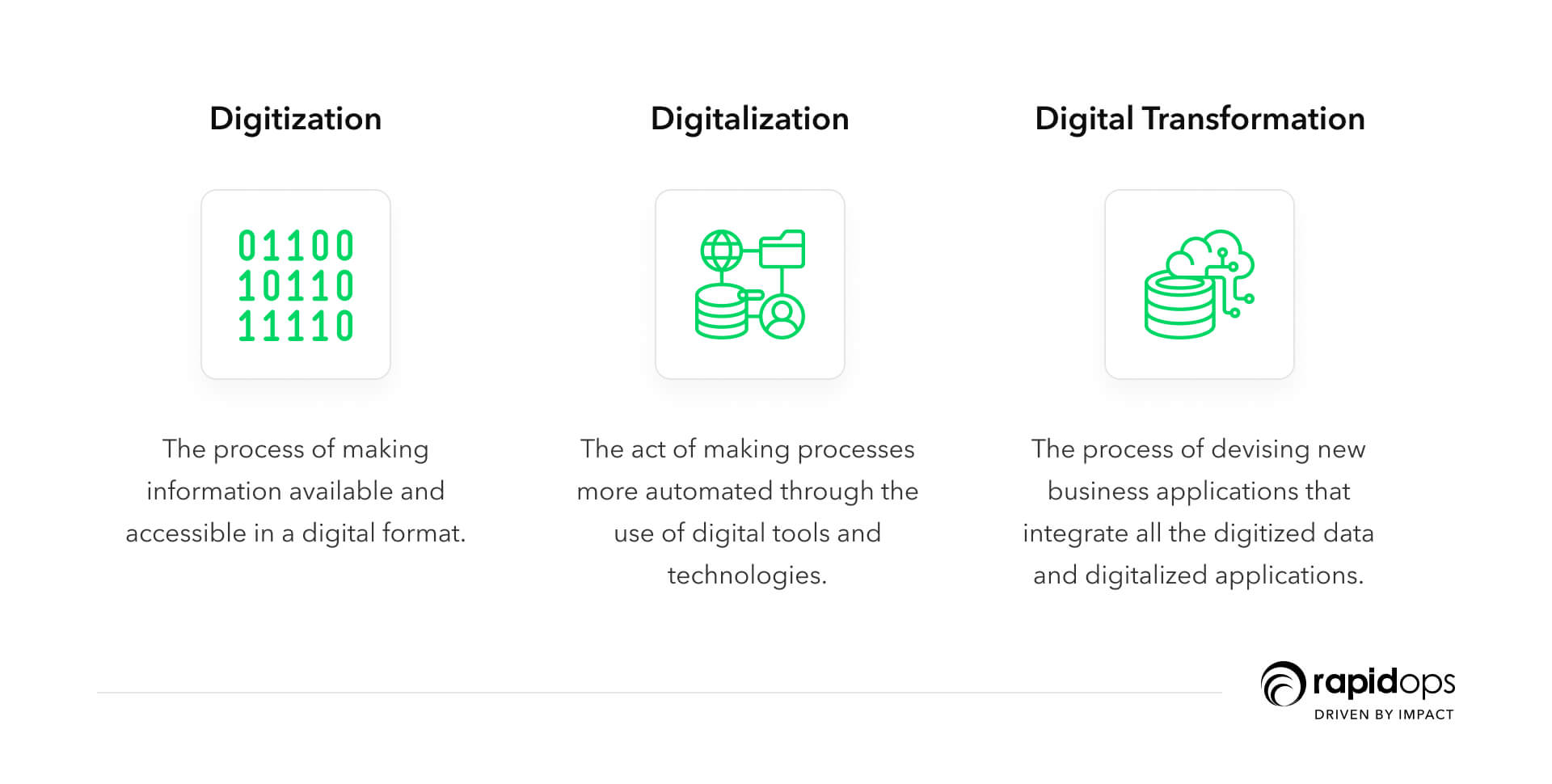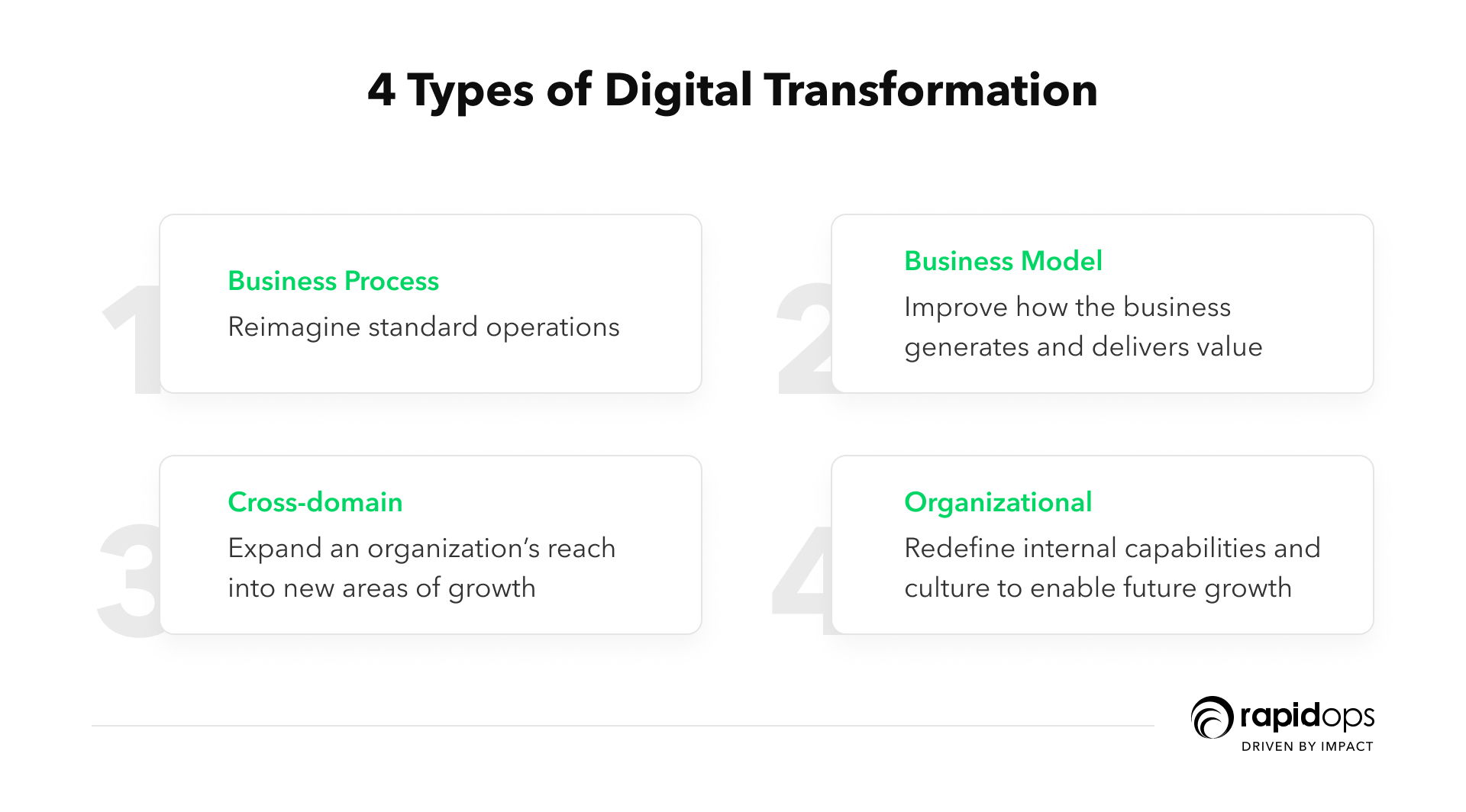Do you want to re-imagine your business digitally? If the answer is "yes," you must know and understand the types of digital transformation. The vision of achieving organizational change depends on choosing the right technologies and merging them with people, processes, and operations.
Digital transformation is an essential component in achieving organizational change. It facilitates businesses with the disruption required for
- Adapting to their market
- Gaining new business opportunities
- Fulfilling the dynamic customer needs
- Driving future growth and innovation
The digital transformation definition
For modern businesses, digital transformation involves integrating digital technology to change their operations and become a digital enterprise to deliver optimal customer value.
What is the difference between digitization, digitalization, and digital transformation?

This section will help you understand the varied requirements an organization can have related to its digital initiatives. Yes, these terms differ, yet they contribute towards the common goal of carrying out digital initiatives. So, let's understand their definitions.
What is digitization?
Digitization primarily involves converting text, pictures, or sound into a digital format that a computer can quickly process. So, you can say that digitization converts information into a digitally manageable format.
This digitization of information allows businesses to extract useful information from non-digital data. If you want to create and store data digitally and use it to drive more value, digitization will act as the enabler.
What is digitalization?
Yes, digitization and digitalization are often used interchangeably and are associated, but they are two different things. Digitalization is the process of enabling or improving business processes by leveraging technologies and digitized data.
Digitalization increases business efficiency and productivity by transforming traditional human-driven processes into software or technology-driven ones.
What is digital transformation?
Digital transformation involves adopting digital technology by a company for improving efficiency, value, or innovation.
[data_analytics_essentials tag="INFORMATIONAL GUIDE" title="Discover the Keys to Digital Transformation Success with Our Comprehensive Guide." button_url="https://www.rapidops.com/resources/digital-transformation-guide/" image="https://www.rapidops.com/blog/wp-content/uploads/2023/05/transformation_guide_new_3@2x.png"]
What are the 4 types of digital transformation?

Digital transformation involves disrupting and re-imagining the existing business processes. Transcendence of traditional business departments such as sales, marketing, and customer success is also part of digital transformation initiatives.
Such re-imagination of business and its processes involves integrating digital tools, re-examining the technological stack, and carrying out the business to keep up with the competition.
Let's continue to explore more of what we briefly covered in our digital transformation guide.
There are 4 main areas of digital transformation that any organization must focus on. We will delve deeper into the types of digital transformation and the areas where businesses must pay attention while carrying out their digital transformation initiative.
1. Business process transformation
Businesses can utilize the power of advanced data analytics, artificial intelligence, machine learning, and other technologies for streamlining and automating their redundant tasks.
With the help of these technologies, everyday business processes will benefit the most by becoming centralized, manageable, and profitable.
Steps that businesses should follow for transforming their process
These steps will attempt to help you make some significant changes to your business process:
a.) Identify your process transformation goals
- Is upgrading the system your primary goal?
- Are you only trying to integrate modern technology?
- Is adopting a more refined process to your new organizational structure the current goal?
Finding correct answers to these questions will help organizations identify their goals of business process transformation.
b.) Determine standard metrics
Start off collecting operational data related to costs, time, and errors. This will help you create baseline parameters that will also help you measure your success after taking the operations transformation initiative.
c.) Centralize your decision-making flow
Keep stakeholders in the loop by involving them in the feedback and knowing what has worked and where you can prioritize the transformation.
d.) Create your best-case scenario
Start creating your process workflow to gauge how much streamlining can be done with your transformation initiative. An ideal workflow will include all your resources inside the framework to see which stage they will best fit.
e.) Kick-off and observe
Create teams to monitor the transformed process's progress and make the required changes to make it a successful initiative.
2. Business model transformation
It is an umbrella term that involves fundamental changes in how a business or organization operates. Such transformations assist organizations to compete for their respective market more effectively by becoming efficient.
Under this transformation, businesses take the initiative on a much broader scale. Instead of focusing their transformation efforts on improving one specific area, the focus is on improving its value generation and delivery by changing personnel, processes, and technology stack.
3. Domain transformation
Domain transformation occurs when an organization can successfully bifurcate or start a new business vertical. For example, Amazon created its own video streaming service and one of the most extensive cloud computing services, AWS (Amazon Web Services).
This transformation requires leveraging present expertise and investments to increase new business opportunities.
4. Organizational transformation
The organizational transformation aims at change management and helps businesses move from where they are at present to where they want to be in the future. The changes facilitate future growth by disrupting and re-imagining the operational mindset, internal processes, and personnel capabilities.
Under this transformation, business leaders bring in agile workflows that counter data and communication silos. Such transformation replaces old processes with technologies such as real-time data analytics aimed to decentralize and fasten decision-making.
Concluding thoughts: Companies must start implementing their digital transformation strategy today!
"It's never over. There is always change and always more to do." – Dr. Koenig, CEO of German's Allianz Health
What is the importance of any technology in its era? For instance, steam engines were prominent when introduced in their era. However, they are now replaced with better and energy-efficient engines. The world has been witnessing such inventions and also their successful application.
We do not need to justify digital transformation. We need to remind you that the current pandemic has proven that organizations that have not transformed their digital landscape have struggled to survive.
For traditional organizations still working with their legacy systems, a more agile digital transformation is most important to grow and not just survive. When a business completely revamps its processes to match the current market requirement, only then they can realize the benefits of digital transformation:
- Enhanced operations
- Better collaboration opportunities
- Expansion of service offerings
- Revolutionized customer experience
Although this article talks about 4 types of digital transformation, the need to execute a digital transformation strategy differs from company to company. Through modern technology, businesses are constantly evolving and undergoing digital changes that improve their efficiency and competitiveness in the marketplace.
However, digital transformation does not end with just implementing new technology. Organizations must think beyond technology to embrace actual digital transformation.
We hope this article helped you understand the four types of digital transformation organizations can implement. It is the segmentation of their digital transformation initiative so that they do not have to worry about the cost of organization-wide transformation.
If you are looking to understand the degree of modernization required to compete in this technology-driven market, you will need the best digital transformation expert for the job.

Saptarshi Das
Content Editor
9+ years of expertise in content marketing, SEO, and SERP research. Creates informative, engaging content to achieve marketing goals. Empathetic approach and deep understanding of target audience needs. Expert in SEO optimization for maximum visibility. Your ideal content marketing strategist.

Let’s build the next big thing!
Share your ideas and vision with us to explore your digital opportunities
Similar Stories
- Transformation
- undefined Mins
- March 2022

- Transformation
- undefined Mins
- March 2020


Receive articles like this in your mailbox
Sign up to get weekly insights & inspiration in your inbox.

